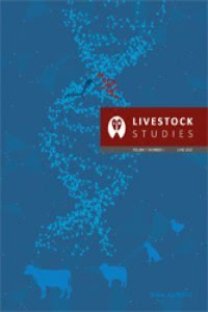ALABALIK (GÖKKUŞAĞI ALABALIĞI) SPERMASININ DONDURULMASI VE DEĞERLENDİRİLMESİ
Bu araştırmada, gökkuşağı alabalığında spermatolojik parametreler ve aralarındaki korelasyonlar değerlendirilmiştir. Ayrıca, iki farklı sulandırıcıyla (Sulandırıcı I ve II) spermalar dondurularak önemli olan spermatolojik özellikler belirlenmiş ve bu sulandırıcıların spermatozoa canlılığı üzerine etkileri incelenmiştir. Spermanın dondurulmasında tesadüfi seçilmiş 24 gökkuşağı alabalığından alınan ejakulatlar kullanılmıştır. Çalışmada kullanılan alabalıklardan, masaj yöntemiyle sperma alınarak spermatolojik özellikler [sperma miktarı (ml), spermatozoa motilitesi (%), spermatozoa yoğunluğu (x 109 /ml), pH] tespit edilmiştir. Sperma iki farklı sulandırıcı kullanılarak, sıvı azot buharında dondurulmuştur. Araştırmada, balıklardan alınan toplam 24 ejakülatta saptanan spermatolojik özelliklerden ejakülat miktarı 19.75±2.07 ml, spermatozoa motilitesi %89.58±1.04, spermatozoa yoğunluğu 12.71±6.37 x 109 spermatozoon/ml ve sperma pH’sı 7.02±0.02 olmuştur. Sperma miktarı ile spermatozoa yoğunluğu arasında negatif yönde bir korelasyon tesbit edilmiştir (p<0.05). Yapılan muayeneler sonucunda sulandırıcı I’de çözüm sonrası spermatozoa motilitesi ve pH sırasıyla %77.08 ve 6.85; sulandırıcı II için ise aynı değerler sırasıyla %72.50 ve 6.79 olarak saptanmıştır. İstatistiki değerlendirme sonucunda sulandırıcı I ve II arasında spermatozoa motilitesi yönünden önemli (p<0.05 ) bir farklılık tespit edilmiştir. Dondurulmuş sperma ile yapılan sun'i tohumlama uygulamalarında ise yine sulandırıcı I ve II için ayrı ayrı denemeler yapılmıştır. Fertilizasyon sonuçları 15. gündeki “göz lekesi” oluşumuna göre yumurtalarda sayım yapılmak suretiyle hesaplanmıştır. Buna göre, sulandırıcı I için %56.08 ve sulandırıcı II için ise %50.05 oranlarında fertilizasyon başarısı elde edilmiştir. Sonuç olarak, alabalık spermasının dondurulabilirliği ortaya konulmuş ve sulandırıcı I (BSA içeriyor), diger sulandırıcıdan çözüm sonu spermatozoa motilitesi ve fertilizasyon oranı açısından daha üstün sonuçlar vermiştir.
Anahtar Kelimeler:
Gökkuşağıalabalığı, sperma, kryopreservasyon, fertilizasyon, sun`i tohumlama
Freezıng And Evaluatıon Of Rainbow Trout (Oncorhynchus mykiss) Semen
In this experiment, the sperm characteristics of Rainbow trout and the correlations between these parameters were assessed. Furthermore, after the semen was frozen by two different extenders (diluent I and II), considerable post-thaw sperm characteristics and the influence of extenders on sperm viability were determined. 24 ejaculates of randomly selected Rainbow trout were used in freezing process. The sperm characteristics [semen volume (ml), sperm concentration (x 109 /ml), sperm motility (%) and pH] were determined in Rainbow trout semen collected by massage method. Semen of the Rainbow trout were cryopreserved in liquid nitrogen vapour using two different extenders. In experiment, totaly 24 ejaculates collecting from Rainbow trout males were treated with regard to principle spermatological characteristics. Ejaculate volume averaged 19.75±2.07 ml, sperm motility 89.58±1.04%, sperm concentration 12.71±6.37 x 109 /ml and sperm pH 7.02±0.02 were established in fresh semen. Negative correlation (p<0.05) was observed between semen volume and sperm concentration. In the results of examinations, the post-thaw sperm motility and pH in the first diluent were 77.08 % and 6.85 %, the same values in the second diluent were 72.50 % and 6.79 % respectively. Statistically significant (p<0.05) differences were observed between two extenders in term of motility. In the applications of artificial insemination by frozen semen, respective tests were carried out for the I and II diluents. The results were evaluated by counting the “eyed egg” on the egg which occured in 15 days after fertilization. And the percentage of fertilization results for the I and II diluent were 56.08 % and 50.05 % respectively. The results of this experiment, suggested that Rainbow trout semen could be frozen and BSA supplemented semen is more beneficial than without BSA for the rainbow trout due to post-thaw motility and fertilization results.
Keywords:
Rainbow trout, semen, cryopreservation, fertilization, artificial insemination,
- Yayın Aralığı: Yılda 2 Sayı
- Başlangıç: 1959
- Yayıncı: Sezer ÖZ
Sayıdaki Diğer Makaleler
KEKLİKLERDE YUMURTA VERİMİ ve KULUÇKA (DERLEME)
ALABALIK (GÖKKUŞAĞI ALABALIĞI) SPERMASININ DONDURULMASI VE DEĞERLENDİRİLMESİ
Ömer AKBULUT, Nilüfer SABUNCUOĞLU
KOYUNLARDA KOÇ ETKİSİNDEN YARARLANARAK KIZGINLIK AKTİVİTESİNİN DÜZENLENMESİ (DERLEME)
Mehmet YARDIMCI, Emine Hesna ŞAHİN1
AFYON İLİ SIĞIR BESİ İŞLETMELERİNDE KÂRLILIK VE VERİMLİLİK ANALİZLERİ
BALARILARINDA ÜREME ÖZELLİKLERİ VE SUN`İ TOHUMLAMANIN KULLANIMI (DERLEME)
